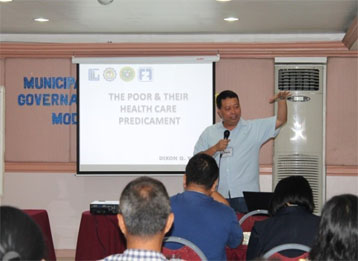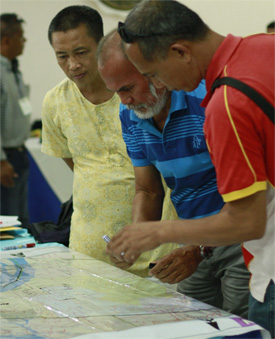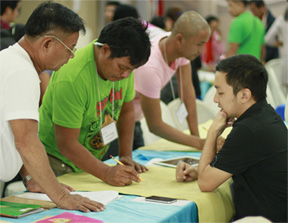“The challenge of the barangay council is competency,” said Dr. Dixon Yasay, Director of the XU Governance and Leadership Institute, emphasizing that the capacity of the council is crucial in facing disaster risks.
This wrapped up the inputs and discussions of the Training-Workshop on Disaster Risk Reduction and Management (DRRM) Planning for Hazard-Prone Barangays of Cagayan de Oro City held on July 15-17 at the Harbor Lights Hotel. The training-workshop was conducted as part of a bigger Xavier University Disaster Risk Reduction and Management (XUDRM) program that aims at capacitating the city at the barangay level for the extreme weather conditions the country now faces every year.
The take-home question for the barangay representatives had been how to maximize not only their financial resources but also their power as a government unit. Although the core of the training-workshop had been on DRRM, the bottom line, as Dr. Yasay stressed in his closing talk, is still effective local legislation. “Wasted powers plus wasted resources equals to poverty,” he said. As had been illustrated in the recent disasters the country faced, the most vulnerable to disasters had been the poor. However, good models have been produced out of some poor communities that were able to strategize and have become resilient despite their limited funds.
The three-day activity started with an input on the Climate Change impacts on Region 10 by Dr. Gemma Teresa T. Narisma, the Associate Director for Research of the Manila Observatory of Ateneo de Manila University. Dr. Narisma explained the reality that we are now facing where extreme weather conditions are no longer occasional events but the ‘new norm’.
This was followed by an input of the City DRRM Plan and Program of Cagayan de Oro. The presentation of the city DRRM plan was to help the barangay council work their plan according to their needs and also align it with adjacent barangays as well as with the broader City-wide DRRM plan.
A talk on the Governance of Disasters given by Dr. Yasay ended the first day, stressing that the risks of the new norm can be mitigated through strategic government planning and implementation of appropriate programs.
The second day was devoted to the mapping of hazards in the barangays, and understanding the risks they face for each hazard. “Risk is the combination of hazards, exposure and vulnerability,” said Engr. Dexter S. Lo, the Director of the Xavier University Engineering Resource Center. He explained to the participants that even as hazards such as flooding and earthquakes occur, if there are no people exposed to such events, there would be no risk and thus no disaster. Similarly, if the people who might be affected by such hazards will be able to prepare and decrease their vulnerability, the risk of disaster would also be minimized.
On the last day, the participants were asked to draft their Barangay Disaster Risk Reduction and Management Plan, drawing from the inputs of the previous days. Participants exchanged problems, suggested solutions and insights with each other, the barangays’ experience with BDRRM planning ranging from none to award-winning plans.
“I thought that our BDRRM Plan was already done,” said Ms. Veluz Umali, a councilor of Barangay 7. “We have attended several seminars on DRRM already but it is only now that we learned of the correct process of doing the plan.” She said they already have the risk maps, for example, but these had not been incorporated in their BDRRM Plan. “After all the inputs, I realized that our plan still lacks several components,” she said.
The barangays are also assigned a coach from Xavier University who will guide them in their formulation of their plans. This is to transfer some of the expertise of the university to the barangays and at the same time mold university staff and faculty for further community engagements.
“As a coach, the training gave me better insight on what I must learn more of,” said Pernalyn Beja, one of the barangay coaches. “The coaching process encourages [the participants] to do better and work on their deliverables. The [training] inputs opened their eyes but the coach will play a big role in their change of behavior.”


